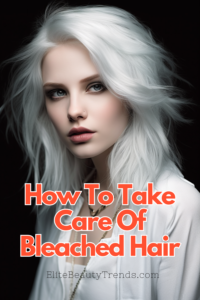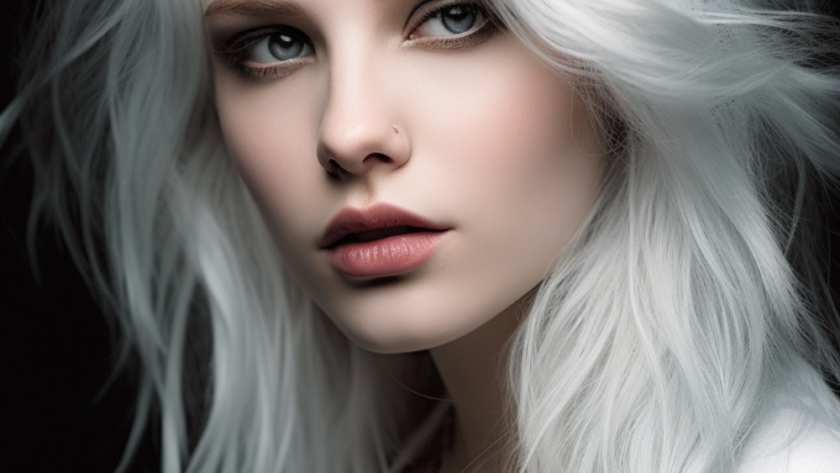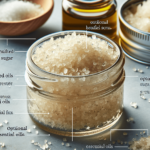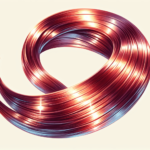If you’ve recently taken the plunge and bleached your hair, you’re probably thrilled with the stunning new shade. However, it’s important to remember that bleached hair requires extra care and attention to maintain its health and vibrancy. From using the right products to implementing a proper hair care routine, this article will guide you through the essential steps for keeping your bleached locks looking their best. Let’s explore the best practices and top tips for taking care of your newfound bleach-blonde tresses.
Choosing a professional hairdresser
When it comes to bleaching your hair, it’s important to find a professional hairdresser who specializes in bleach services. Reading reviews and seeking recommendations from friends or family who have had their hair bleached can be a great starting point. These firsthand experiences can provide valuable insights into the quality of service and the results achieved by different hairdressers.
Checking the qualifications and experience of a hairdresser is also essential. Look for certifications or qualifications that indicate the hairdresser has received proper training in bleaching techniques. Additionally, consider the hairdresser’s level of experience in working with bleached hair. An experienced hairdresser will likely have a better understanding of the unique needs and challenges associated with maintaining bleached hair.
Before committing to a hairdresser, it’s a good idea to consult with them to discuss your desired outcome and any concerns you may have. This conversation can help you gauge the hairdresser’s expertise, communication skills, and understanding of your specific needs. Taking the time to choose a professional hairdresser who is qualified, experienced, and aligned with your vision can greatly contribute to a successful and satisfying hair bleaching experience.
Preparing your hair before bleaching
Prior to bleaching your hair, it’s important to prepare it properly to minimize damage and achieve optimal results. One of the essential steps in pre-bleaching preparation is getting a trim. Trimming your hair removes any split ends, making it less prone to breakage during the bleaching process. This ensures that your hair remains as healthy as possible, even after the bleaching treatment.
Deep conditioning your hair is another crucial step in preparing your hair for bleaching. Bleaching can strip your hair of its natural oils, leaving it dry and brittle. Deep conditioning treatments help replenish moisture, nourish the hair, and improve its overall health. Prioritize deep conditioning your hair in the weeks leading up to the bleaching appointment to ensure that it’s in the best possible condition.
During the pre-bleaching phase, it’s important to avoid heat styling your hair. Heat styling tools such as straighteners, curling irons, or blow dryers can further damage hair that is already vulnerable due to upcoming bleaching. Using heat styling tools restricts the hair’s ability to retain moisture, making it more prone to breakage. To protect your hair, embrace natural hairstyles, and let your locks air dry whenever possible.
Try these best-sellers:
Olaplex Hair Perfector No 3 Repairing Treatment: This at-home treatment reduces breakage and strengthens hair, making it a great option for preparing your hair before bleaching.
Briogeo Don’t Despair, Repair! Deep Conditioning Mask: This is a cruelty-free and natural product that is 6-Free—formulated without sulfates, silicones, phthalates, parabens, DEA, or artificial dyes.
Protecting your hair during the bleaching process
The bleaching process itself can be quite harsh on your hair, which is why taking steps to protect it is crucial. One effective way to safeguard your hair during bleaching is by using a protective barrier. Before applying the bleach, use petroleum jelly or a similar product to create a protective layer on your scalp, hairline, and ears. This serves as a barrier, preventing the bleach from coming into direct contact with your skin, reducing the risk of irritation or chemical burns.
When applying the bleach, it’s important to do so carefully. Follow the instructions provided by your hairdresser and ensure that the bleach is applied evenly and thoroughly. Avoid applying excessive amounts of bleach as this can lead to damage or uneven results. Additionally, be mindful of not oversaturating previously bleached sections of hair when touching up roots or performing color corrections, as this can cause unnecessary overlapping and increased damage.
Try: Manic Panic Flash Lightning Hair Bleach Kit: This is a vegan and cruelty-free bleaching kit.
Maintaining moisture after bleaching
After the bleaching process, it’s crucial to focus on maintaining moisture in your hair. Start by using a sulfate-free shampoo. Sulfates are harsh cleansing agents that can strip the hair of its natural oils and further contribute to dryness. Opting for a sulfate-free shampoo will help preserve the moisture in your hair, leaving it softer and more manageable.
Following shampooing, it’s important to use a hydrating conditioner. Look for a conditioner specifically formulated for bleached or damaged hair. These products often contain moisturizing ingredients and can help restore and nourish your hair. Leave the conditioner on for a few minutes before rinsing to give it time to penetrate the hair shaft and provide optimal hydration.
In addition to using a regular conditioner, incorporating leave-in conditioners into your hair care routine can provide extra moisture and protection. Leave-in conditioners are designed to be applied to damp or dry hair and can help control frizz, detangle strands, and provide ongoing moisture throughout the day. Apply a small amount of leave-in conditioner to the mid-lengths and ends of your hair, focusing on the areas that need the most attention.
- Pureology Hydrate Moisturizing Shampoo: 100% vegan and sulfate-free.
- Acure Ultra Hydrating Conditioner: Vegan, sulfate-free, and cruelty-free.
Avoiding excessive washing
While cleanliness is important, excessive washing can strip your hair of its natural oils, leaving it dry and vulnerable. To preserve moisture and prolong the health of your bleached hair, it’s essential to limit hair washing frequency. Aim to wash your hair every two to three days rather than daily, as this allows your natural oils to nourish and protect the hair.
Dry shampoo can be a lifesaver when it comes to stretching time between washes. It absorbs excess oil and adds volume to your hair, giving the appearance of freshly washed locks. Apply dry shampoo to your roots, focusing on the areas that tend to become greasy. Gently massage it into your scalp and brush the powder through your hair, distributing it evenly.
When washing your hair, avoid using hot water. Hot water can open the cuticles of your hair, leading to moisture loss and further damage. Instead, opt for lukewarm or cool water to help seal the cuticles and retain moisture. Cooler water temperatures also have the added benefit of giving your hair a healthy shine.
Try the: Klorane Dry Shampoo with Oat Milk: Vegan, sulfate-free, and cruelty-free.
Protecting hair from heat damage
Heat styling tools can be damaging to any hair type, but they can be particularly harmful to bleached hair. To protect your hair from heat damage, it’s crucial to use heat protectant products. Look for sprays or serums specifically designed to shield your hair from high temperatures. Apply the heat protectant product to your hair before using any heat styling tools to create a barrier between the heat and your strands.
Lowering the heat settings on your styling tools is another way to minimize damage. High heat can cause the hair to become brittle and susceptible to breakage. Lowering the temperature on your straightener, curling iron, or blow dryer reduces the risk of overexposure to heat. While it may take slightly longer to achieve your desired hairstyle, it’s worth it in terms of maintaining the health and integrity of your bleached hair.
In addition to lowering heat settings, it’s essential to avoid excessive heat styling. Give your hair a break from heat as often as possible, opting for natural hairstyles or alternative methods of achieving the desired look. Embrace your hair’s natural texture, experiment with heatless styling techniques, and allow your hair to air dry whenever time permits. This will help minimize damage and give your hair the chance to recover and regain strength.
Try: Giovanni 2Chic Flat Iron Styling Mist: USDA Certified Organic, cruelty-free and vegan.
Avoiding excessive brushing
While brushing can help detangle and style your hair, excessive brushing, especially when your hair is wet, can lead to breakage and damage. To minimize the risk of damage, use a wide-tooth comb or a brush specifically designed for wet hair. These tools help gently detangle your hair without causing unnecessary breakage. Start at the ends and work your way up to the roots, being patient and gentle as you remove any knots or tangles.
When your hair is wet, it’s in a more fragile state, making it susceptible to damage. Avoid brushing wet hair whenever possible and instead opt for finger detangling or using a wide-tooth comb. If you must brush your hair when wet, be extra cautious and gentle to avoid breakage. Hold your hair at the roots while you slowly and gently brush through the strands, supporting the hair to minimize tension and stretching.
During detangling, it’s important to be gentle to avoid causing breakage or damage. Use your fingers or a wide-tooth comb to separate tangled strands, rather than forcefully pulling or yanking on the hair. Take your time and proceed with patience, working through the tangles gradually. This gentle approach will help minimize stress on your hair, ensuring that it remains as healthy as possible.
Try: EcoTools Detangler Hair Brush: Made from plant-based plastic, cruelty-free, and vegan.
Protecting hair from UV damage
Just like your skin, your hair can also be damaged by harmful UV rays. Protecting your hair from the sun is particularly important if you have bleached hair, as it is more susceptible to damage. Wearing a hat or scarf is an effective way to shield your hair from direct sunlight. This simple step not only protects your hair from UV rays but also helps prevent moisture loss and keeps your scalp shaded.
Using hair products that contain UV protectants is another way to safeguard your hair from sun damage. Look for leave-in conditioners, serums, or styling sprays that specifically mention UV protection on the label. These products are formulated to create a shield against harmful UV rays, minimizing the damage caused by sun exposure. Apply the UV-protectant product to your hair before heading out into the sun to provide ongoing protection throughout the day.
Limiting sun exposure is another effective measure to protect your hair from UV damage. During peak hours of sunlight, the sun’s rays are at their strongest, posing a greater risk of damage to your hair. If possible, stay in shaded areas or seek shelter from direct sunlight during these times. By minimizing your hair’s exposure to the sun, you can help maintain its health, color, and overall condition.
Try: Coola Organic Scalp & Hair Mist SPF 30: Vegan, cruelty-free, and reef-friendly.
Avoiding harsh chemicals
To maintain the health and integrity of your bleached hair, it’s important to avoid exposing it to harsh chemicals as much as possible. One of the main culprits in this regard is hair dye. Bleached hair is already more porous and vulnerable to damage, and adding hair dye to the mix can exacerbate these issues. If you’re tempted to switch up your hair color, consult with your hairdresser on the best options for achieving your desired look without compromising the health of your hair.
Another aspect to consider is being cautious with styling products. Some hair sprays, gels, or mousses may contain drying alcohols or other ingredients that can further dehydrate your already bleach-processed hair. Opt for styling products that are specifically formulated for dry or damaged hair, as these are often enriched with moisturizing ingredients. Always read the labels of the products you use and avoid those that contain harsh chemicals or ingredients that can be damaging to your hair.
For those who enjoy spending time in the pool, minimizing exposure to chlorinated water is crucial. Chlorine can be highly damaging to bleached hair, causing it to become dry, frizzy, and brittle. Before swimming, wet your hair thoroughly with clean, non-chlorinated water to help limit the amount of chlorinated water that your hair absorbs. Consider wearing a swim cap to further protect your hair, or rinse it immediately after swimming to help remove any chlorine residue. Using a clarifying shampoo or a chelating treatment once a week can also help remove any build-up or traces of chlorine from your hair.
Try: SheaMoisture Coconut & Hibiscus Curl Enhancing Smoothie: Free of harmful ingredients and cruelty-free.
Investing in regular deep conditioning treatments
Regular deep conditioning treatments are key to keeping your bleached hair nourished, hydrated, and strong. Hair masks are an excellent way to deliver intense moisture and essential nutrients to your hair. Look for masks specifically designed for bleached or damaged hair, as these are often formulated with ingredients that target and repair the specific needs of chemically treated hair. Apply the hair mask once a week, focusing on the mid-lengths and ends. Leave it on for a recommended amount of time, allowing the product to deeply penetrate the hair shaft and provide much-needed repair.
Try: Shea Moisture Manuka Honey & Mafura Oil Intensive Hydration Treatment Masque: This product is cruelty-free and formulated with natural and certified organic ingredients.
In addition to hair masks, incorporating oils into your hair care routine can provide additional hydration and nourishment. Natural oils such as coconut oil, argan oil, or jojoba oil can help strengthen the hair shaft, reduce frizz, and add shine. Apply a small amount of oil to your damp or dry hair, focusing on the ends, where damage is most likely to occur. Avoid applying oil directly to your roots, as this can make your hair appear greasy.
Try: Viva Naturals Organic Extra Virgin Coconut Oil: USDA-certified organic and cruelty-free.
While regular at-home treatments are beneficial, visiting a salon for professional deep conditioning treatments is also highly recommended. Professional treatments often involve specialized products and techniques that can provide deep hydration and repair. Your hairdresser will be able to analyze the condition of your bleached hair and recommend the most suitable treatment for you. Regular salon treatments can contribute significantly to maintaining the overall health and quality of your bleached hair.
In conclusion, taking care of bleached hair requires a combination of proper preparation, protection during the bleaching process, and a consistent maintenance routine afterward. By choosing a professional and experienced hairdresser, preparing your hair beforehand, protecting it during the bleaching process, and committing to a post-bleaching care routine, you can ensure that your bleached hair remains healthy, vibrant, and beautiful. Remember to prioritize moisture, avoid excessive washing and brushing, protect your hair from heat and UV damage, minimize exposure to harsh chemicals, and invest in regular deep conditioning treatments. With these practices in place, you can enjoy the stunning results of your bleached hair while keeping it in its best possible condition.






